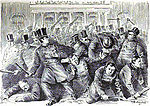150 Nassau Street

150 Nassau Street, also known as the Park Place Tower and the American Tract Society Building, is a 23-story, 291-foot (89 m) building in the Financial District of Lower Manhattan in New York City. It is located at the southeast corner of Spruce Street and Nassau Street, next to 8 Spruce Street, the former New York Times Building, and New York City Hall. 150 Nassau Street was built in 1894–1895 as the headquarters of the American Tract Society (ATS), a nonprofit, nonsectarian but evangelical organization that distributed religious tracts. Designed by the architect R. H. Robertson, it is one of the first skyscrapers built from a steel skeleton and was among New York City's tallest buildings when it was completed. 150 Nassau Street is located near Park Row, which contained several newspaper headquarters. The building failed to make a profit during ATS's occupancy, and the New York Life Insurance Company foreclosed on the building in 1914. After ATS moved out, the New York Sun occupied the building from 1914 to 1919. The building's 10th through 23rd floors were converted into condominiums between 1999 and 2002. In 1999, it was designated as a city landmark by the New York City Landmarks Preservation Commission. The American Tract Society Building is also a contributing property to the Fulton–Nassau Historic District, a National Register of Historic Places district created in 2005.
Excerpt from the Wikipedia article 150 Nassau Street (License: CC BY-SA 3.0, Authors, Images).150 Nassau Street
Nassau Street, New York Manhattan
Geographical coordinates (GPS) Address External links Nearby Places Show on map
Geographical coordinates (GPS)
| Latitude | Longitude |
|---|---|
| N 40.711388888889 ° | E -74.005833333333 ° |
Address
Nassau Street 150
10038 New York, Manhattan
New York, United States
Open on Google Maps








